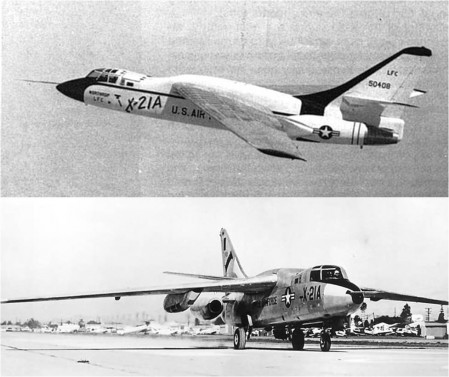Forty-nine years ago today, the USAF/Northrop X-21A Laminar Flow Control (LFC) experimental aircraft exhibited a significant reduction in skin friction drag. This achievement marked the first time in aviation history that the LFC principle was successfully demonstrated in flight. Perhaps aviation’s greatest holy grail is the pursuit of technology that allows a laminar boundary layer to be maintianed over the entire surface of an aircraft. Doing so holds the promise of significantly reducing the overall drag and thereby markedly increasing aircraft range and endurance performance. Maintaining a laminar boundary layer is difficult since the boundary layer is naturally turbulent over most of the aircraft at flight Reynolds numbers. The X-21A LFC system was based on the principle of boundary layer removal. This was achieved by drawing surface airflow through a series of fine, porous slots machined into the upper and lower surfaces of the wing. Airflow suction was provided by laminar flow control pumps located in nacelles on the underside of the wing. A pair of existing USAF B-66D Destroyer airframes were converted to the X-21A LFC configuration. Following conversion and checkout, Ship No. 1 (S/N 55-0408) first flew on Thursday, 18 April 1963 with Northrop test pilot Jack Wells doing the honors. On this initial test hop, the X-21A flew from Northrop’s Hawthorne Airport facility to Edwards Air Force Base, California. The first successful flight demonstration of aircraft drag reduction occurred on Tuesday, 14 May 1963. Ultimately, the X-21A demonstrated laminar flow control on about 75% of the type’s wing surface. Aircraft handling was satisfactory even with asymmetric boundary layer state on opposing wings (i.e., one wing with laminar flow and the other with turbulent flow). However, the Achilles Heel of LFC is the natural flight environment itself wherein dust, dirt, particulates and even bugs clog the boundary layer suction slots. LFC system maintenance is a nightmare; laborious, time-consuming and expensive. While clearly successful, the X-21A LFC Program came to an end in 1964. Despite its promise and allure, no operational production aircraft has ever utilized an LFC system.
Make Your Career Soar


